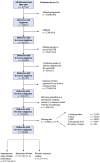Maternal postpartum infection risk following induction of labor: A Danish national cohort study
- PMID: 39737539
- PMCID: PMC11782083
- DOI: 10.1111/aogs.15035
Maternal postpartum infection risk following induction of labor: A Danish national cohort study
Abstract
Introduction: Induction of labor is a common procedure, and in Denmark, approximately one in four vaginal deliveries are induced. The association between induction and maternal postpartum infections such as endometritis, surgical site infection after cesarean section, urinary tract infection, and sepsis has been sparsely investigated. Our objective was to investigate the association between induction of labor and risk of maternal postpartum infection and to identify potential risk factors for infection.
Material and methods: In a nationwide cohort study, all deliveries with live-born singletons from January 1, 2007, to December 31, 2017 (n = 546 864) were included. Deliveries were grouped into categories of spontaneous onset of labor, induction of labor, and elective cesarean section. The primary outcome was any infection within 30 days postpartum based on discharge diagnosis codes and redeemed antibiotic prescriptions for endometritis, surgical site infection, urinary tract infection, and sepsis. Analyses were done using logistic regression.
Results: Infection within 30 days postpartum was found among 8.5% of the women undergoing induction of labor compared to 6.8% of the women with spontaneous onset of labor. In adjusted logistic regression analyses, the risk of postpartum infection was significantly increased after induction of labor compared to spontaneous onset of labor (adjusted ORs [aOR], 1.24; 95% confidence interval [CI], 1.21-1.27). Women with rupture of membranes were not at increased risk of postpartum infection (aOR 1.01; 95%CI 0.94-1.09). The risk of postpartum maternal sepsis was not significantly associated with induction of labor. Antibiotic treatment during pregnancy, pre-eclampsia, and long education were all associated with increased risk of maternal postpartum infection, while either a low or high body mass index and previous deliveries were associated with decreased risk.
Conclusions: Induction of labor was associated with an increased risk of maternal postpartum infection. However, the absolute risk was 1.7% higher for the women with induced labor compared to spontaneous onset of labor, which we believe should not be a cause for concern. Unexpectedly, low and high body mass index was associated with decreased risk of infection, and rupture of membranes was not associated with increased risk after induction of labor, which might reflect actual clinical management.
Keywords: birth; birth complications; endometritis; infection; postpartum infection; sepsis; surgical site infection; urinary tract infection.
© 2024 The Author(s). Acta Obstetricia et Gynecologica Scandinavica published by John Wiley & Sons Ltd on behalf of Nordic Federation of Societies of Obstetrics and Gynecology (NFOG).
Conflict of interest statement
The authors report no conflict of interest.
Similar articles
-
The relation between low-grade fever during prolonged rupture of membranes (>12 hours) at term and infectious outcomes: a retrospective cohort study.Am J Obstet Gynecol. 2024 Sep;231(3):361.e1-361.e10. doi: 10.1016/j.ajog.2024.05.054. Epub 2024 Jun 11. Am J Obstet Gynecol. 2024. PMID: 38871240
-
Postpartum infection in relation to maternal characteristics, obstetric interventions and complications.J Perinat Med. 2018 Apr 25;46(3):271-278. doi: 10.1515/jpm-2016-0389. J Perinat Med. 2018. PMID: 28672754
-
Postoperative infections after non-elective cesarean section - a retrospective cohort study of prevalence and risk factors at a single center in Denmark administering prophylactic antibiotics after cord clamping.BMC Pregnancy Childbirth. 2022 Dec 17;22(1):945. doi: 10.1186/s12884-022-05300-y. BMC Pregnancy Childbirth. 2022. PMID: 36528589 Free PMC article. Review.
-
Maternal and neonatal outcomes associated with induction of labor after one previous cesarean delivery: A French retrospective study.PLoS One. 2020 Aug 7;15(8):e0237132. doi: 10.1371/journal.pone.0237132. eCollection 2020. PLoS One. 2020. PMID: 32764773 Free PMC article.
-
Postpregnancy genital tract and wound infections.J Midwifery Womens Health. 2008 May-Jun;53(3):236-246. doi: 10.1016/j.jmwh.2008.01.007. J Midwifery Womens Health. 2008. PMID: 18455098 Review.
Cited by
-
Exploring the risks of postpartum infections: Insights from labor induction practices.Acta Obstet Gynecol Scand. 2025 Jun;104(6):1222. doi: 10.1111/aogs.15106. Epub 2025 Mar 25. Acta Obstet Gynecol Scand. 2025. PMID: 40130684 Free PMC article. No abstract available.
References
-
- Nyfødte og fødsler (1997‐). Accessed January 29, 2024. Available from: https://www.esundhed.dk/Emner/Graviditet‐foedsler‐og‐boern/Nyfoedte‐og‐f...
-
- World Health Organization . WHO recommendations for induction of labor. 2011. Accessed January 29, 2024. https://iris.who.int/handle/10665/44531
-
- Triebwasser J, VanArtsdalen J, Kobernik E, Seiler K, Langen E. Assessing maternal and fetal risks associated with prolonged induction of labor. Am J Perinatol. 2019;36:455‐459. - PubMed
-
- De Vivo V, Carbone L, Saccone G, et al. Early amniotomy after cervical ripening for induction of labor: a systematic review and meta‐analysis of randomized controlled trials. Am J Obstet Gynecol. 2020;222:320‐329. - PubMed
MeSH terms
LinkOut - more resources
Full Text Sources


